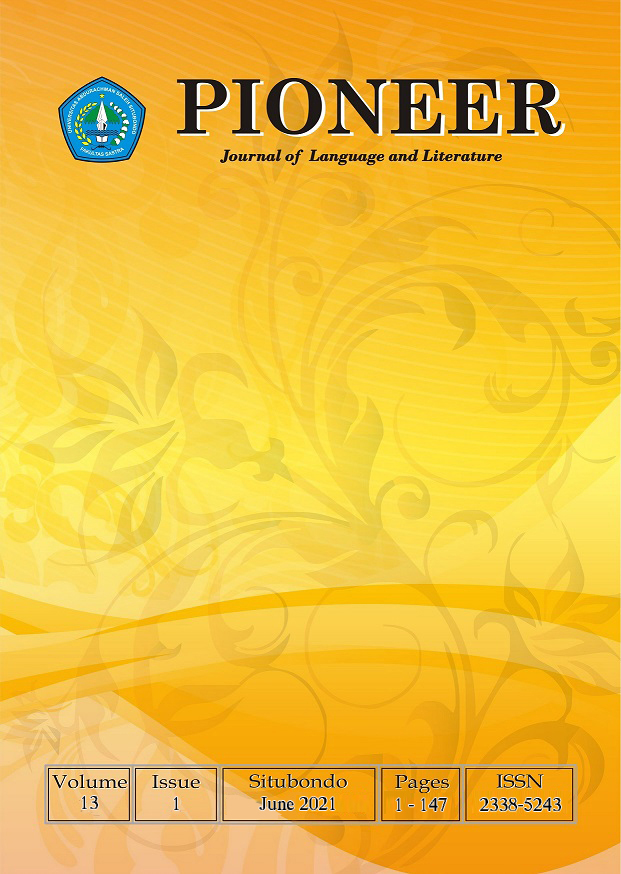The Representation of Masculinity in Men's Health Magazine on Advertisements
Multimodal Discourse Analysis
Abstract
Advertisements become engaging media to introduce and promote products. Men as masculine creation become one of interesting visual to represent the product and engage the target market. This study aims to discuss the visual and linguistic elements in the advertisements. In addition, this study reveals the interplay of those elements to make meaning and masculinity portrayal in the advertisements. The data are Nivea Crème, Pond’s face wash, Versace Eros perfume, and Skechers shoes. The theory used in this study is visual images by Kress and van Leeuwen (2006) and SF-MDA by Halliday and Matthiessen (2004), supported Generic Structured Potential by Cheong’s framework (2004). This research used the descriptive qualitative method. Therefore, it is in the form of words, sentences, and images. The result of this study indicates that the representation of masculinity is changing over time. Masculinity portrayal such as stylish, independence, actives in sport, and character such as adventurous, strong, calm, muscular body are found in the data. The producer uses process material with goal, attributive, circumstance to represent the product to the targeted market.
Downloads
References
Butt, David g, E. a. (2000). Using Functional Grammar: An Explorer’s Guide. In TESOL in Context (Second Edi, Vol. 5). Sydney: National Centre for English Language Teaching and Research Macquarie University.
Connell, R. W. (2005). Masculinities (Second Edi). Berkeley and Los Angeles, California: University of California Press.
Courtenay, W. (2003). Key Determinants of The Health and Well-Being of Men and Boys. International Journal of Men’s Health, 2(1), 1–30. https://doi.org/10.3149/jmh.0201.1
Creswell, J. W. (2013). John W. Creswell-Research Design_ Qualitative, Quantitative, and Mixed Method Approaches-SAGE Publications (2013).pdf.
Dina, M., & Ariyanti, L. (2017). Gender Feature in Women and Men’s Skin Care Advertisements. Language Horizon, 05(01), 108–117.
Edwards, T. (2005). Cultures of masculinity. In Cultures of Masculinity (First Edit). https://doi.org/10.4324/9780203005224
Goddard, A. (1987). The Language of Advertising. In the veterinary quarterly (Vol. 9). https://doi.org/10.1080/01652176.1987.9694128
Goffman, E. (1976). Gender Advertisements (First Edit; E. Goffman, Ed.). New York United States of America: Harper and Row.
Habib, Ratnaningsih, & Nisa. (2019). The Construction of The Ideal Male Body Masculinity in The Mister International Pageant. Jurnal Urban Sosiology, 2(2).
Halliday, M. A. K., & Matthiessen, C. M. I. M. (2004). An Introduction to Functional Grammar. Retrieved from https://www.functionalmedicine.org/files/library/Intro_Functional_Medicine.pdf
Kress, G. (2010). Multimodality (First edit; G. Kress, Ed.). New York and London: Routledge.
Kress, G., & Leeuwen, T. van. (2006). Reading Images (The Grammar of Visual Design) (Second edi). London and New York: Routledge.
Kress, G., & Van Leeuwen, T. (2002). Colour as a semiotic mode: Notes for A Grammar of Colour. Visual Communication, 1(3), 343–368. https://doi.org/10.1177/147035720200100306
Lubis, Duma Sari, Sinar, T. S. (2014). The Structure of Selected Print Advertisement: A Multimodal Analysis. Journal of Chemical Information and Modeling, 161–177. https://doi.org/10.1017/CBO9781107415324.004
Ningsih, Erna fitria, Tallapessy Albert, S. R. (2014). The Ideational Meaning in Electronics Devices Advertisements in Jawa Pos: A Systemic Functional Linguistic Multimodal Discourse Analysis. 2(Multimodal in electronics devices), 1–14.
O’Halloran, K. L. (2004). Systematic Functional Perspective (K. L. O’Halloran, Ed.). York, London: Continuum.
O’Halloran, K. L. (2008). Systemic Functional Multimodal Discourse Analysis (SF-MDA): Constructing Ideational Meaning using Language and Visual Imagery. In Sage Publications (Vol. 7, pp. 443–475). https://doi.org/10.1177/1470357208096210
O’halloran Kay L, & Bradley, A. S. (2012). Multimodal studies: Exploring issues and domains. In K. L. O’Halloran (Ed.), Multimodal Studies: Exploring Issues and Domains (First edit). https://doi.org/10.4324/9780203828847
Reed, A. N. (2013). Eros and Psyche from Apuleius to paranormal romance : a communication analysis of the archetype’s message. Eastern Washington University.
Rubio-hernández, M. del M. (2010). The Representations Of Men Depicted In Men’s Health Magazine. Revista Comunicación, 1(8), 57–70.
S. Knox, J. (2013). Multimodality and Systemic Functional Analysis. In The Encyclopedia of Applied Linguistics (First edit, pp. 1–7). https://doi.org/10.1002/9781405198431.wbeal0836
An author who publishes in Pioneer: Journal of Language and Literature agrees to the following terms:
- Author retains the copyright and grants the journal the right of first publication of the work simultaneously licensed under the Creative Commons Attribution-ShareAlike 4.0 License that allows others to share the work with an acknowledgement of the work's authorship and initial publication in this journal
- Author is able to enter into separate, additional contractual arrangements for the non-exclusive distribution of the journal's published version of the work (e.g., post it to an institutional repository or publish it in a book) with the acknowledgement of its initial publication in this journal.
- Author is permitted and encouraged to post his/her work online (e.g., in institutional repositories or on their website) prior to and during the submission process, as it can lead to productive exchanges, as well as earlier and greater citation of the published work (See The Effect of Open Access).

























